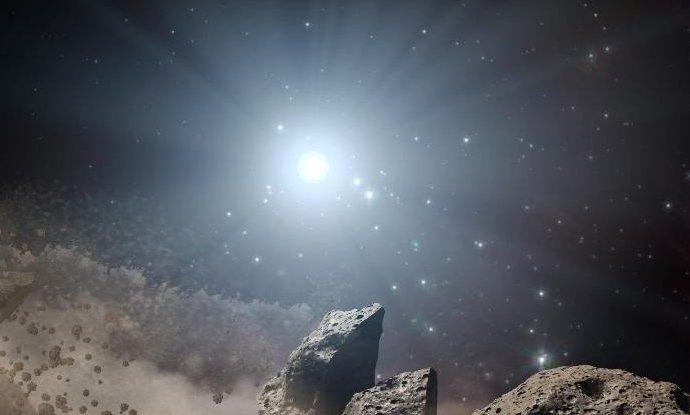In 2015, astronomers found something weird. It was a white dwarf star, 570 light-years from Earth, with a peculiar dimming pattern. It dimmed several times to varying depths, each depth repeating on a 4.5 to 5-hour timeframe; and its atmosphere was polluted with elements usually found in rocky exoplanets.
Source: Science Alert
It didn’t take long before they figured it out. The gravity of the dead star was in the process of shredding and devouring bodies in orbit around it, a violent process known rather politely as tidal disruption.
The star is called WD 1145+017, and it’s now being used as a proof of concept for a new field of planet study, forensic reconstruction of planetary bodies to understand what they were like, and how they died.
Astronomers from the US and the UK are calling this field necroplanetology.
Their analysis of WD 1145+017 has been accepted into The Astrophysical Journal, and is available on arXiv. And it could, the researchers say, be applied to future discoveries similar to the white dwarf system to piece together how planets die orbiting different kinds of dead stars.
Although white dwarfs eject a lot of material when they die in a series of violent thermonuclear explosions, planets can somehow survive the process. Not only have we found planets in orbit around white dwarf stars, we have found elements in the atmospheres of white dwarf stars that are usually found inside rocky exoplanets.
The surface gravity of white dwarfs is so intense that these heavier elements would sink quite quickly, indicating that the star must have accreted the material quite recently, from a body that survived the star’s death throes.
To try and determine how WD 1145+017 got the way it did, astronomers from the University of Colorado, Boulder, Wesleyan University, and the University of Warwick in the UK conducted a series of simulations to place constraints on the tidally disrupted body.
They tweaked structural components of an orbiting body, such as the size of the core and mantle; the composition of the mantle, rocky or icy; and the presence of a crust. This resulted in 36 different simulated bodies.
Then, they set each of these 36 bodies orbiting a star like WD 1145+017, around 60 percent of the mass of the Sun, and 2 percent of its size (white dwarfs are pretty dense).
This orbit was 4.5 hours, as per the material orbiting WD 1145+017, and each simulation ran for 100 orbits. And finally, the resulting light curves for the tidal disruption of each body were then compared with the real-life light curve of WD 1145+017.
These simulations showed that the bodies most likely to produce what we observe in WD 1145+017 have a small core, and a low-density mantle, “resembling an asteroid with a partially differentiated structure and volatile-rich mantle like Vesta,” the researchers wrote in their paper.
The bodies are relatively low mass, and have bulk density high enough to maintain structure for a while, but low enough that their mantles are disrupted. These attributes are consistent with the lack of small particles found in other observations of the star, since these would sublimate quickly.
And, in fact, they offer some clues as to other mysterious stars as well – such as the famous KIC 8462852, AKA Tabby’s star, whose inconsistent dimming is a source of much puzzlement among astronomers.
KIC 8462852, since its strange behaviour was first discovered, has turned out not to be the only star exhibiting such strange dimming. A survey last year turned up another 21 strangely dimming stars that could have similar dynamics.
And other white dwarfs slurping down orbiting bodies have been discovered, too. ZTF J0139+5245 and WD J0914+1914 were both discovered tidally disrupting planets last year.
These stars could be simulated using the team’s new methods, too.
“These are the first members of a larger class of dying planetary systems that must be studied by pairing spectroscopic and photometric observations with disruption simulations, either tidal as in WD 1145+017 or rotational as Veras et al. (2020) proposes for the body transiting ZTF J0139+5245,” the researchers wrote in their paper.
“This multi-pronged approach would use the death of these planetary systems in action to study fundamental properties of exoplanetary bodies that are otherwise inaccessible: a study in necroplanetology.”
The research has been accepted into The Astrophysical Journal, and is available on arXiv.
Source: Science Alert

































Leave a Comment
You must be logged in to post a comment.